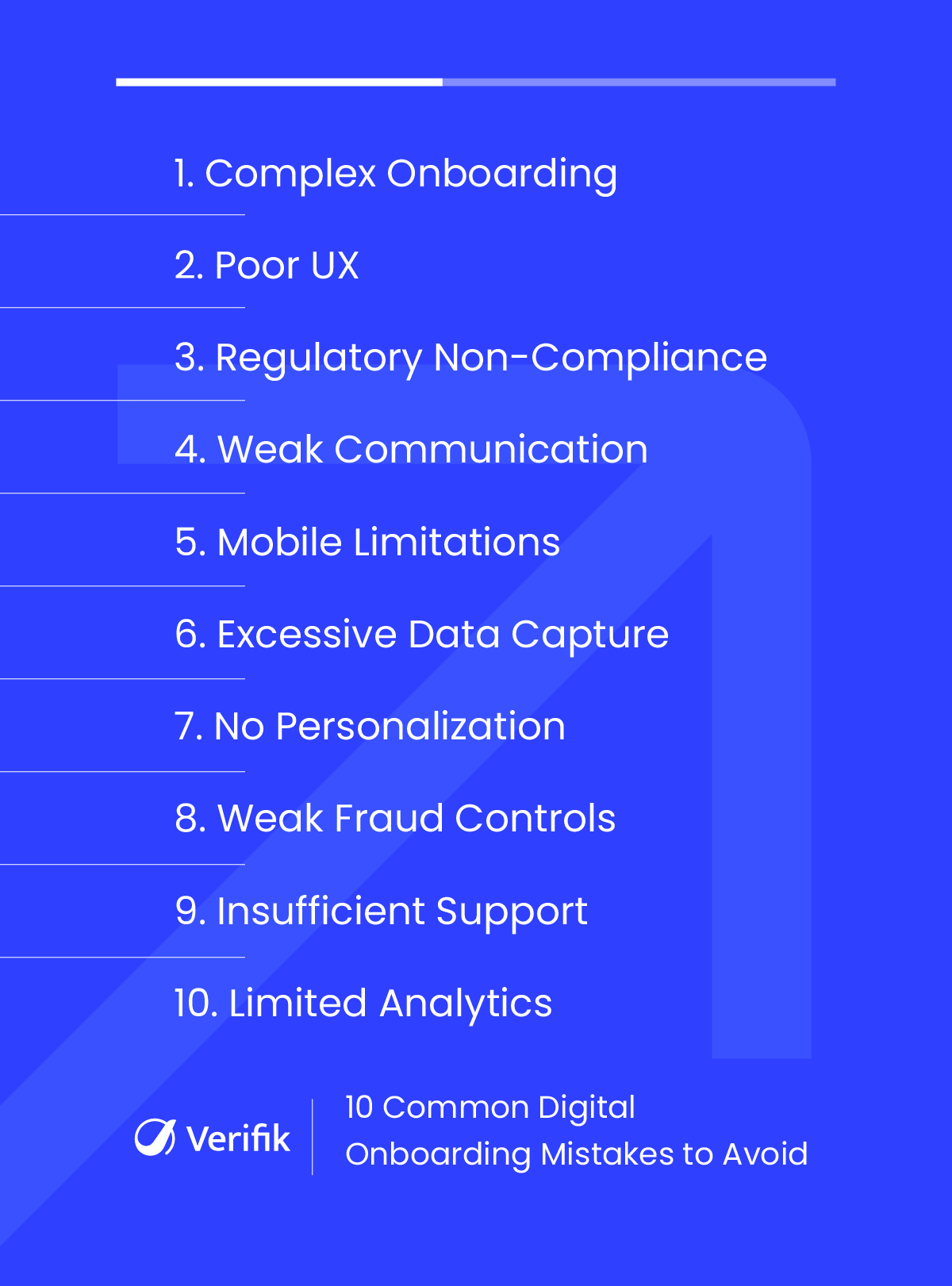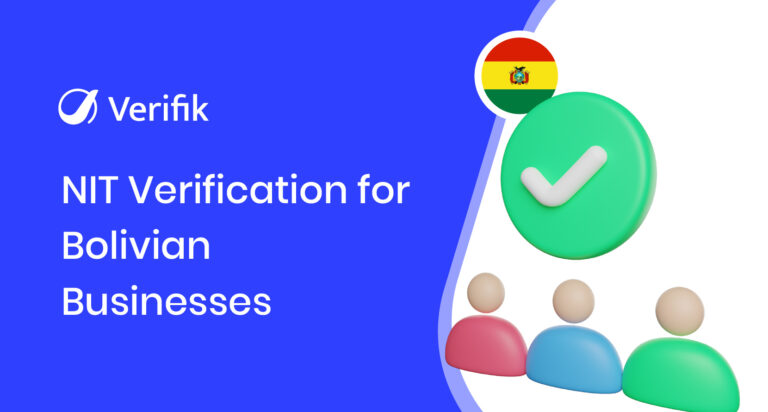Digital onboarding has become the go-to solution for banks, fintechs, and digital platforms aiming to welcome new customers with convenience and speed. However, while the process promises efficiency, many businesses fall into avoidable mistakes that create friction, weaken compliance, and even lead to customer churn. Understanding these pitfalls will help you refine your onboarding strategy and build long-lasting trust with your users.
In this blog, we will highlight the 10 most common digital onboarding mistakes and how to avoid them for a smoother, more secure customer journey.
1. Overcomplicating the Process
One of the biggest mistakes companies make is designing onboarding flows that are too lengthy or confusing. Customers today expect speed and simplicity. If your digital onboarding requires too many steps, multiple document uploads, or repetitive form filling, users are likely to drop out midway.
How to Avoid It:
- Keep forms short and only ask for information that is strictly necessary.
- Introduce progressive data collection where you gather details step by step.
- Use automation to pre-fill data and reduce manual entry.
Streamlined onboarding saves time for the customer and increases completion rates, which directly impacts conversion.
2. Neglecting User Experience (UX)
A poor user interface can ruin even the most secure onboarding process. Tiny fonts, confusing layouts, unclear error messages, or inconsistent design can frustrate new users. Since onboarding is the very first interaction with your brand, a bad UX can immediately reduce trust.
How to Avoid It:
- Prioritize mobile-first design since most users complete onboarding via smartphones.
- Provide clear instructions and instant feedback when errors occur.
- Test the onboarding flow with real users to identify friction points.
An intuitive and smooth experience shows that your business values customer convenience.
3. Ignoring Regulatory Compliance
For industries such as banking, insurance, and fintech, compliance with KYC (Know Your Customer), AML (Anti-Money Laundering), and GDPR is non-negotiable. Cutting corners or using outdated systems can expose your business to fines and reputational damage.
How to Avoid It:
- Integrate automated identity verification tools that are compliant with global standards.
- Ensure user data is encrypted and securely stored.
- Regularly audit your onboarding process for compliance gaps.
Balancing compliance with convenience is the key to building trust while meeting legal requirements.
4. Lack of Clear Communication
Many businesses fail to explain the onboarding steps to customers. This leaves users confused about what information is required, how long the process will take, or why sensitive data is being requested. Unclear communication can cause mistrust and abandonment.
How to Avoid It:
- Display progress indicators to show how far along the user is in the process.
- Provide short explanations about why documents or data are needed.
- Use plain language instead of technical jargon.
Transparency builds confidence and reassures customers that their data is being handled responsibly.
5. Poor Mobile Optimization
Mobile is now the dominant channel for digital onboarding, but many companies still design their flows primarily for desktop. Forms that don’t fit the screen, image uploads that fail, or apps that crash on mobile lead to poor user adoption.
How to Avoid It:
- Optimize your onboarding journey for mobile-first interactions.
- Enable easy camera-based document scanning and selfie verification.
- Ensure fast load times and responsive design across different devices.
When your onboarding is mobile-friendly, you meet users where they are and encourage faster conversions.

6. Asking for Too Much Information Upfront
Customers are wary of sharing personal information unless they clearly understand why it is necessary. Asking for excessive details at the very start not only delays the process but also makes users question your intentions.
How to Avoid It:
- Only collect critical information upfront, such as name and email.
- Request additional details later in the journey when trust has been built.
- Use data validation tools to avoid repeated requests for the same information.
This approach reduces friction and ensures customers don’t feel overwhelmed.
7. Lack of Personalization
A generic onboarding journey that treats all users the same often fails to engage. For instance, a small business owner opening a corporate account will have different needs compared to an individual opening a savings account. Without personalization, users may feel the process is irrelevant or unnecessarily complicated.
How to Avoid It:
- Segment users based on their profiles or use cases.
- Personalize forms, instructions, and product recommendations accordingly.
- Offer multiple onboarding paths for different customer categories.
Personalized onboarding not only improves satisfaction but also strengthens long-term loyalty.
8. Inadequate Fraud Prevention Measures
Digital onboarding is often targeted by fraudsters who exploit weak verification systems. Relying solely on basic ID checks can expose your platform to identity theft, fake accounts, and financial losses.
How to Avoid It:
- Implement multi-layered identity verification, such as facial recognition, liveness detection, and document validation.
- Use AI-powered fraud detection to flag suspicious patterns.
- Continuously update fraud-prevention protocols based on emerging threats.
A strong fraud prevention strategy protects both your business and legitimate customers.
9. Ignoring Customer Support
Even with the best-designed onboarding process, users may face issues like rejected documents, unclear requirements, or technical errors. If customers cannot reach support quickly, they may abandon the process altogether.
How to Avoid It:
- Offer real-time chat support or AI-powered assistants during onboarding.
- Provide a clear “help” section with FAQs and troubleshooting guides.
- Ensure that customer support agents are trained to handle onboarding queries efficiently.
Accessible support ensures users complete onboarding without unnecessary frustration.
10. Failing to Measure and Improve
Many businesses launch their onboarding journey and then stop monitoring its performance. Without analyzing completion rates, drop-off points, and user feedback, you cannot identify what’s working and what needs improvement.
How to Avoid It:
- Track onboarding metrics such as average completion time, abandonment rates, and user satisfaction scores.
- Run A/B tests on different onboarding flows to optimize performance.
- Continuously refine the process based on real data.
Digital onboarding isn’t a destination, but a journey. It must constantly evolve to keep pace with customer expectations and technological advancements.
Final Thoughts
Digital onboarding is the first impression your business makes, and getting it wrong can cost you valuable customers. By avoiding these 10 common mistakes—ranging from poor UX and compliance gaps to weak fraud prevention—you can create a process that is smooth, secure, and customer-friendly.
If you want to ensure your onboarding strategy truly drives growth and customer trust, make sure simplicity, compliance, personalization, and support remain at the core of your process.
Make Your Onboarding Effortless with smartENROLL
Onboarding should feel effortless, not complicated. With smartENROLL, Verifik helps your business verify users swiftly and securely while keeping compliance at the center.
Our solution takes care of every step:
- Enroll – Seamlessly capture and register users.
- Database Screening – Instantly validate identities against trusted sources.
- Scan Docs – Verify documents in real time for authenticity.
- Access – Grant entry only to verified users.
With smartENROLL, you gain a complete onboarding platform that minimizes friction, stops fraud, and builds user confidence from day one.
Book a free 30-min demo today and see smartENROLL in action!













